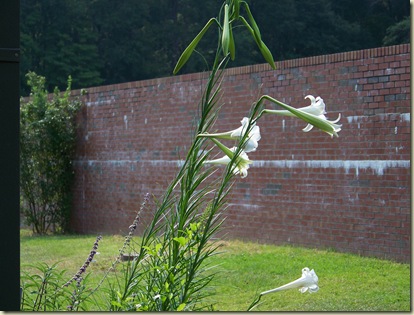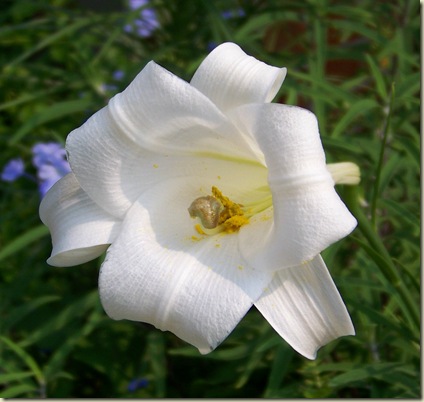The Formosa lilies are blooming. We have one growing here at the house but there are several at school and there used to be many growing along U.S. 27 South until some "improvement project" a few years ago bush-hogged and back-hoed them into apparent extinction. These are sunflower-tall lilies with large white flowers: they are hard to miss. Each bears up to 12 narrow trumpets atop 5-8 foot stalks in mid to late summer. The flowers in this picture are 7 or more inches long.
Formosa lily, Lilium formosum, is also known as the Taiwan Lily. Introduced in our country in 1880 from Taiwan, which was formerly known as Formosa, it is now endangered there. It didn’t catch on here until it was re-introduced in 1918 by E.H. Wilson, the famous British plant collector who made many expeditions to China.
A USDA site showed these lilies only naturalized in Louisiana and Florida, but there was a disclaimer at the bottom, so it is not a definitive map. Many websites are selling the bulbs. It has become an invasive, exotic species in parts of Australia.
it is considered an herb and is a monocot. Grass and corn are monocots, emerging from the ground as a blade, instead of the preleaves (cotyledons) of, say, a bean, which is a dicot. There are other differences between monocots and dicots, but this is one of the more obvious.
They freeze back in the winter, but return from a bulb each summer. The flowers produce large seedpods containing many seeds, each of which is capable of growing a blooming plant the next summer. The Australia pages even speak of the leaves being able to form new plants, thus brush piles were a contributing factor to their spread.
In Europe, the lily was considered protective against witchcraft and was hung on the door for that purpose. With its sweet fragrance and impressive size, I'd say, the Formosa lily is, itself, bewitching.


No comments:
Post a Comment